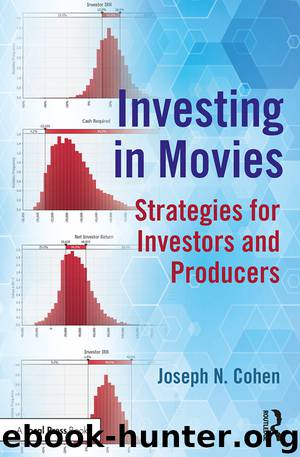Investing in Movies by Cohen Joseph N.;

Author:Cohen, Joseph N.;
Language: eng
Format: epub
Publisher: Taylor & Francis Group
Ninth, I would like to see a full breakdown of locations and studio facilities to be used together with a comprehensive timetable covering, pre-production, principal photography and post-production. Finally, I would like to see projections covering at least five likely performance scenarios, which would be provided not by the producers, but by an independent financial analyst—with obviously the normal “forward looking statement” caveat included.
Different people find different ways of having fun in the movie business. I am talking about civilians here—i.e., non-professionals. Some love to read scripts, although I have not always found much of a positive correlation between money and taste. Even experienced producers, if they are smart, surround themselves with experienced development executives, whose job it is to vet projects, assess scripts and give extensive notes on how the script can be improved. Yes, opinions are subjective, but smart, experienced development executives have been through the wars and have seen what works and what doesn’t work over a multitude of submissions. Just because the development executive is half your age, that doesn’t mean his or her opinion (many more development executives are women) shouldn’t count for much. Also, many films are aimed at a millennial audience, and you can’t expect a middle-aged white male producer to appreciate much of the material aimed at that younger audience.
Other investors like to visit the set—generally for not too long, because being on a set is like watching paint dry. Before you can shoot a scene, you first have to block it, determining where the actors will be on the set and the first camera position, then the director of photography has to light the set and position the camera for the first shot, then there is the camera rehearsal of the first set-up with the actors and crew, then you have to make lighting and other adjustments—all this before you can even shoot the first scene when the director will orchestrate multiple takes of a particular shot. A one-take occurs when the entire scene is shot satisfactorily the first time. Needless to say, if that occurs it’s generally by happy accident. So most of the time, if you hang out on a set, you will be checking emails on your phone. Maybe investors also hope to hang out with the stars—but if that is their hope, rarely will they get much more than a brief introduction. Time is money on the set, and a good producer (as well as a good agent) will want to shield his talent from any distractions that interfere with their ability to perform.
Finally, many investors really enjoy going to festivals, where there is glitz and more time to hang out with the stars. But festivals are not just an opportunity to showcase the film and hopefully garner positive critical reviews. Festivals are also a place to nail down distribution deals—taking advantage of the overall buzz the film generates. The most important festivals that also double as markets, where distribution deals are made, are Sundance (January), Berlin (February), Cannes (May) and Toronto (September).
Download
This site does not store any files on its server. We only index and link to content provided by other sites. Please contact the content providers to delete copyright contents if any and email us, we'll remove relevant links or contents immediately.
Shoot Sexy by Ryan Armbrust(17162)
Portrait Mastery in Black & White: Learn the Signature Style of a Legendary Photographer by Tim Kelly(16498)
Adobe Camera Raw For Digital Photographers Only by Rob Sheppard(16410)
Photographically Speaking: A Deeper Look at Creating Stronger Images (Eva Spring's Library) by David duChemin(16174)
Bombshells: Glamour Girls of a Lifetime by Sullivan Steve(13137)
Art Nude Photography Explained: How to Photograph and Understand Great Art Nude Images by Simon Walden(12376)
Perfect Rhythm by Jae(4641)
Pillow Thoughts by Courtney Peppernell(3446)
The Book of Joy by Dalai Lama(3257)
Good by S. Walden(2930)
The Pixar Touch by David A. Price(2753)
Fantastic Beasts: The Crimes of Grindelwald by J. K. Rowling(2558)
A Dictionary of Sociology by Unknown(2527)
Humans of New York by Brandon Stanton(2387)
Read This If You Want to Take Great Photographs by Carroll Henry(2314)
Stacked Decks by The Rotenberg Collection(2295)
On Photography by Susan Sontag(2146)
Photographic Guide to the Birds of Indonesia by Strange Morten;(2100)
Insomniac City by Bill Hayes(2094)
